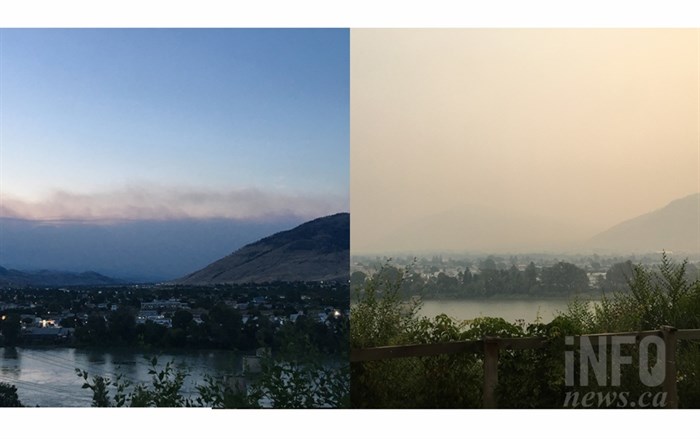
This view overlooking the Thompson River shows how much smoke has moved into Kamloops overnight. The image on the the left was taken on July 9, 2017 at 9:25 p.m. and the image on the right was taken on July 10 at 8:25 a.m.
(ASHLEY LEGASSIC / iNFOnews.ca)
July 10, 2017 - 4:49 PM
Health authorities are warning anyone with breathing difficulties to stay inside following a smoky skies advisory issued because of forest fires.
The special air quality statement was issued by Environment Canada and the Interior Health Authority today, July 10. The blanket statement applies to the Cariboo, Thompson, Shuswap, Okanagan, Similkameen, Fraser Canyon and Nicola regions.
Kamloops resident Cheryl Kabloona has a lung disease and takes part in the Purple Air project. It's a citizen science project where anyone can buy and install air quality monitoring systems and results are posted online.
"I have a lung disease that I'm trying to be careful about. I get a scratchy throat when I'm out in the smoke, but not having trouble breathing yet," Kabloona says. "My lung capacity is lower than it would be, the last thing I want to do is let it get worse. I'd like to keep what I have."
As long as the smoke lingers, Kabloona will stay indoors with the windows closed and thinks other should do the same.
"I think everybody should be careful right now. It concerns me to see people walking outside for exercise. It's not healthy."
Kamloops has the worst air quality in the province, according to Environment Canada's air quality index. It fluctuates, but at 2:45 p.m. on July 10, Kamloops was rated at 10 plus, or 'very high risk.' The Central Okanagan, North Okanagan and South Okanagan are at seven, or 'high risk.'
"The air quality health index is a way of relating what's in the air to the health risks it poses," Alyssa Charbonneau, Environment Canada meteorologist says.
The takes more than one pollutant into account, it also includes ozone, fine particulate matter and nitrogen dioxide, all common pollutants harmful to human health, she says.
Everyone should avoid strenuous outdoor activities, but exposure is especially a concern for elderly, kids and infants or anyone with medical conditions, according to the statement.
When the smoke turns to a heavy bluish-white haze, the smoke concentrations are higher than normal, according to Interior Health. Negative effects of the smoky skies include coughing, throat irritation, headaches or shortness of breath.
WorkSafe B.C., Environment Canada and Interior Health would not comment on any dangers people working outside might face when the air quality index gets high.
To get caught up on the Southern Interior wildfire situation, go here.
To check the air quality in your area, check B.C Air Quality online or check the status of the air quality statement here.
To contact a reporter for this story, email Kim Anderson or email the editor. You can also submit photos, videos or news tips to the newsroom and be entered to win a monthly prize draw.
We welcome your comments and opinions on our stories but play nice. We won't censor or delete comments unless they contain off-topic statements or links, unnecessary vulgarity, false facts, spam or obviously fake profiles. If you have any concerns about what you see in comments, email the editor in the link above.
News from © iNFOnews, 2017